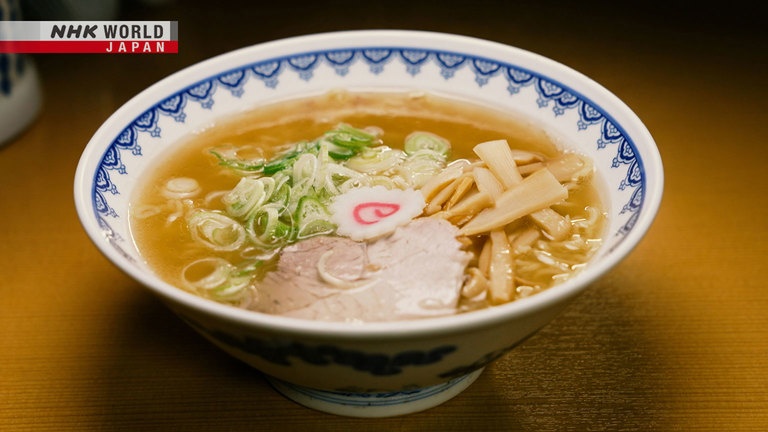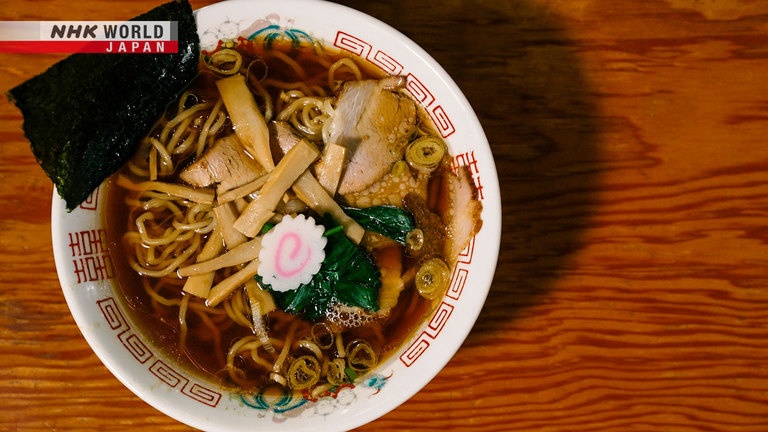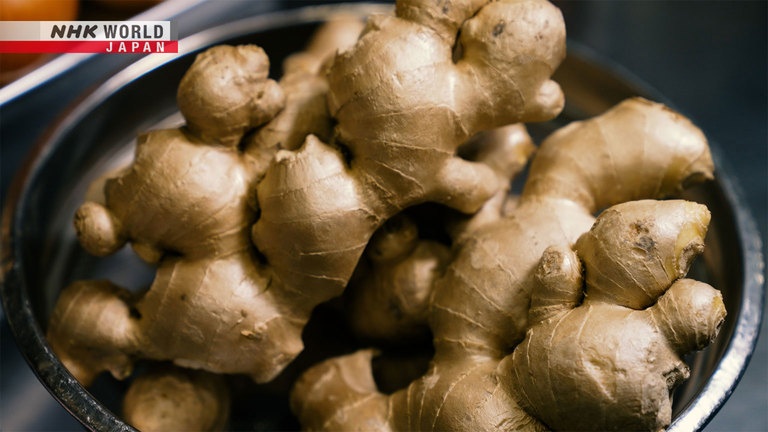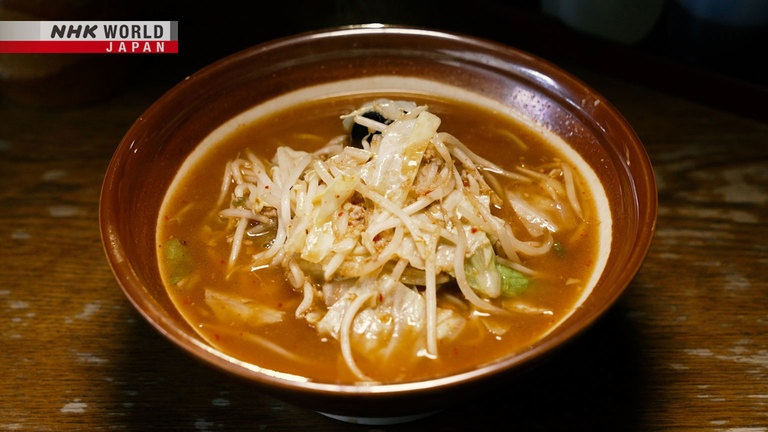NIIGATA Part 1
Niigata Prefecture is one of Japan's foremost ramen hotspots. Let's explore the diversity of the city's beloved ramen dishes.




Transcript
Ramen Japan!
We're in Niigata prefecture, second-ranked in ramen consumption in Japan.
Various kinds of ramen originate from the area.
We'll serve distinctive bowls in two episodes.
Welcome to Japan, the land of ramen!
Niigata is Japan's top rice production region.
As rice is the main ingredient, the area is also famous for its sake.
Niigata is also indispensable in its production of ingredients essential to Japanese cuisine.
In winter, being one of Japan's heaviest snowfall areas,
this region along the Sea of Japan is covered in deep snow.
Ramen arrived in the area in 1927.
It all began with this Chinese restaurant.
This simple bowl of ramen, marked the beginning of Niigata's ramen culture.
Katayama Takahiro, an editor at a local magazine, is an expert on Niigata ramen.
Born and raised in Niigata, Katayama calls himself "The Niigata Ramen Evangelist."
He claims to have eaten about 4,000 bowls of ramen in 20 years.
He will be our guide.
There are five kinds of ramen
I want you to try in Niigata.
Whoa, five kinds?
The first is the clear golden soup ramen.
Not too fatty, and you can slurp it easily.
It's Niigata's light shoyu ramen.
Niigata City is the largest city in the prefecture, with a population of about 770,000.
Shinano River, Japan's longest river, flows into the Sea of Japan at this point.
In 1869, the fifth international trading port in Japan opened here.
The area between Shinano River and the Sea of Japan is called "Niigata Island."
To unload and transport cargo, a moat was built around Niigata Island.
It was a place of great activity.
Many food stalls lined the moat.
It's there ramen stands started to appear.
This ramen stall was established in 1956.
It's still in business.
Niigata's earliest style of ramen originated from a food stall.
Third-generation owner Mitsui Atsushi succeeds in keeping the original taste.
The soup is very pale and clear.
Soup stock ingredients vary between shops.
Here, they use pork bone with a pinch of dried sardine,
which are cooked over a low heat just under a boil.
I love all kinds of ramen.
But mostly the light soup ones.
Food stall culture played a significant role in the origin of this ramen.
Food stalls weren't supplied
with much power back then.
They couldn't maintain the heat
needed to cook thick broth.
Clear soup came from this low heat.
This shop in Niigata Island was established in 1957.
Welcome!
Niigata Island was the city's commercial district.
People wanted to eat something after drinking.
That's how it began.
There was a reason for thin noodles.
Food stalls didn't have much power.
Thinner noodles didn't take long to cook.
This meant the drunks got served faster.
In this way, light shoyu ramen came to be.
Food like ramen, bananas,
and eggs were treats back then.
You only got them when sick.
Our ramen was 35 yen when we started.
Now, it's 700 yen, 20 times more!
I came here during junior high
about half a century ago.
My daughter wanted to come here.
So, I took her here.
- It's good.
- You won't say it's bad, right?
We've been at it for 67 years.
When a triple-generation family comes,
I realize how long we've been around.
This bowl, which originated in a food stall in the commercial district, still defines the flavor of the old days.
About sixty kilometers south of Niigata City lies Nagaoka City.
This region records some of the heaviest snowfall within the prefecture.
The ramen born in this heavy snow country is...
The contrast between appearance and
taste provides a unique sensation.
This shop originated ginger shoyu ramen.
A characteristic of this ramen is its aroma, which cannot be conveyed on the screen.
It's soy sauce-based with a hint of ginger.
This place is the best.
It goes great with beer.
A big pint, of course!
A huge amount of ginger is mixed in with the pork bone stock.
Why add ginger to the ramen?
The reason has been passed down through the generations.
Its inclusion at first was to hide
the smell of pork bones.
Katayama believes there is another reason why this ramen is so loved in Nagaoka.
It has an immediate warming effect.
Because of the cold in Nagaoka,
its popularity spread.
That's how ginger shoyu ramen was born and continues to evolve.
Welcome!
Ginger is in the soy sauce.
We also add some before serving.
We kept getting asked
for more ginger.
Patrons can also grate and add their own.
Eat the ramen steaming hot and enjoy the aroma of fresh ginger.
Today's third ramen type was born in a hot spring area.
To the east of Niigata City is Nishikan.
It's a stretch of wide plains and mountains.
A post-station town from the 17th century, it retains the ambiance of olden days.
It is here Niigata miso ramen originated.
This restaurant opened in 1973.
I hear they started by offering miso ramen.
It's very nice.
Founder Watanabe Toshiaki.
He is the first to serve Niigata-style miso ramen.
He was running a small restaurant with his mother when he had a chance to try Hokkaido-style miso ramen.
Miso ramen exists?
I was surprised.
Everyone thought it was radical.
Eventually, Watanabe pursued his own, original miso recipe.
Miso transforms in many ways,
more so than soy sauce.
That's why I became fascinated with miso.
He blends more than eight varieties of miso for his ramen.
However, his differs from Hokkaido-style miso ramen.
I wanted it thick and rich.
And that's what I got.
To compensate, ramen is served with thinning broth.
Guests at hot spring resorts
would request delivery service.
But after drinking alcohol, they'd often want
something lighter than thick, salty ramen.
We serve it as we like,
but offer thinning broth on the side.
This unique serving style spread throughout the hot spring resorts.
It wasn't an instant hit but word got out.
Besides, ramen's cheaper than sushi.
Watanabe took on many apprentices.
This shop is owned by one of them.
We blend miso varieties from Kyoto,
Okayama, Uonuma, and Niigata.
Each came up with their original miso blend.
Still, their soups are consistently rich.
With thinning broth on the side.
I've been coming here for 30 years.
I like miso flavor.
This ramen is my favorite.
I always order miso ramen here.
I love it. Especially with garlic.
"Is the taste heavy?"
Yes, but there's thinning broth.
I didn't use it.
I feel like heavy ramen today.
Katayama's five choices of Niigata ramen.
Next, we'll introduce his final two selections,
which will surely exceed your wildest ramen expectations!
Stay tuned!